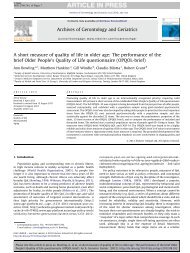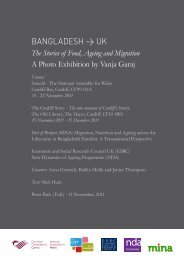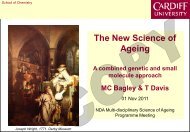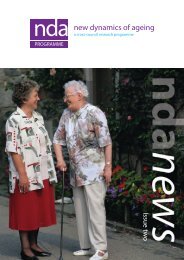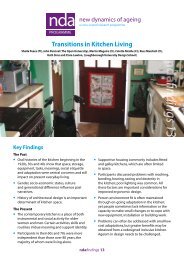Lynn McInnes - New Dynamics of Ageing
Lynn McInnes - New Dynamics of Ageing
Lynn McInnes - New Dynamics of Ageing
- No tags were found...
Create successful ePaper yourself
Turn your PDF publications into a flip-book with our unique Google optimized e-Paper software.
THE NEW DYNAMICS OF AGEINGPROGRAMME –‘EARLY FINDINGS‘NDA Programme Meeting November 2009
Mapping a mobility pr<strong>of</strong>ile <strong>of</strong> the'oldest-old' survivors <strong>of</strong> alongitudinal study <strong>of</strong> ageingDr <strong>Lynn</strong> <strong>McInnes</strong> (Northumbria University)Pr<strong>of</strong>essor Pam Briggs (Northumbria University)Dr Linda Little (Northumbria University)Pr<strong>of</strong>essor <strong>Lynn</strong> Rochester (<strong>New</strong>castle University)
<strong>Ageing</strong>• <strong>Ageing</strong> associated with:– Sensory changes– Physical changes– Cognitive changes• Impact on mobility• NDA grant examining mobility in an oldergroup <strong>of</strong> people
Effects <strong>of</strong> poor mobility• Restricted social lives/social interaction• Limited access to leisure and other activities• Limited access to good nutrition– Adults with restricted mobility found to be consuminginsufficient amounts <strong>of</strong> fruit and vegetables (Whylie,Copeman, & Kirk, 1999).
Effects <strong>of</strong> poor mobility• Loss <strong>of</strong> independenceOlder people have a desire to stay independent butreport that mobility interferes with this wish(Sidonvall, Nydahl, & Fjellstorm, 2001)• Loss <strong>of</strong> bone density• Physical health problemsIncreased risk <strong>of</strong> weight loss found inparticipants with a limitation in mobility(Bannerman et al, 2002)
Predictors <strong>of</strong> mobility?• Understanding predictors as well asconsequences <strong>of</strong> mobility important toguide interventions to reduce mobilityproblems associated with ageing.
Aim <strong>of</strong> study• To utilise innovative methods for mapping themobility <strong>of</strong> the oldest-old members <strong>of</strong> an existing25 year old longitudinal study <strong>of</strong> ageing.– Activity monitoring methods and state-<strong>of</strong>-the-artlocation aware technologies to develop new metrics.– These will then be used to describe the relationshipbetween mobility and physical and mental well-being– To identify predictors and consequences <strong>of</strong> mobility
North East Age Research• Longitudinal dataset (25 years)• Pr<strong>of</strong> Pat Rabbitt• 3384 volunteers recruited / 300 survivors• Periodically assessed• Extensive information on– Cognitive ability– Health– SES– Activities– Lifestyle (alcohol & tobacco use etc)
4 Objectives <strong>of</strong> Study1. To establish a sophisticated mobilitypr<strong>of</strong>ile <strong>of</strong> the oldest old.
<strong>New</strong> technology for assessing mobility
<strong>New</strong> technology for assessing mobility• Accelerometry (activity monitors)small monitors strapped to thigh musclemap activityregister stepping movements <strong>of</strong> legsregister changes in body positionused to assess activity (Busse et al. 2004)but do not give context <strong>of</strong> activity
<strong>New</strong> technology for assessing mobility• Location based GPS (i-locate device)devices worn or carriedrelay location <strong>of</strong> wearernot used to track but to monitor and trace (i.e.plotting an individual’s geographicalmovements over both space and time)log the extent and variability <strong>of</strong> activity across daysand week.Gives some indication <strong>of</strong> context (e.g. location, speed)Concerns: accuracy, usability, privacy
Assessing mobility• Time use diariesSelf-ratedGives contextAccuracy?
All 3 measures together– Using location based technologies (i-locate,Trackaphone) to provide an objectivemeasure <strong>of</strong> activity but ‘at home’ or ‘in shop’– Using Accelerometer data (ActivPAL) toobjectively quantify intensity and type <strong>of</strong>activity e.g. ‘housework at home’, ‘sitting inshopping centre’– Using time use diaries to provide self-reports<strong>of</strong> activities and context
2. To establish an accurate picture <strong>of</strong>current health and lifestyle <strong>of</strong> theoldest-old.Interviews, tests and questionnaires give current information on:• daily activities,• health• social engagement,• cognitive and sensory acuity• physiological indices <strong>of</strong> balance and gait (using gait analysis).• nutrition and diet• depression, anxiety, sleep• fear <strong>of</strong> fallingTaken together these measures will establish a reliablehealth and lifestyle pr<strong>of</strong>ile <strong>of</strong> the current ‘oldest old’cohort.
3. Combine current data withlongitudinal data to model predictorsand consequences <strong>of</strong> mobility in theoldest old.Map mobility against indices <strong>of</strong> successfulageing.
Recruitment• 308 contact letters out.• 213 responses• 146 wished to take part• 100 invited to take part• 86 completed tests
Methodology• Initially participants completedquestionnaires.– Personal details update– Pittsburgh sleep quality index (PSQI)– Impact <strong>of</strong> new technologies (specificallylocation based services) on privacy.– Activity diary for 7 consecutive days
Gait assessed over a 10 meter walk using GaitRiteelectronic walking system.Single and dual tasks (auditory stroop).
Other measures• Timed get up and go• Height and weight
i-locate and ActivPAL• Following return <strong>of</strong> activity diaryparticipants visited in home to deliver andprovide instructions on how to wear theaccelerometer and the i-locate device.• Wear both for 7 consecutive days.
i-locate device
Second lab visit – cognitive testing• Cognitive status– CANTAB (the Cambridge neuropsychological automated testingbattery).– The Mini Mental State Exam (MMSE).• Fluid intelligence– Culture Fair test (Cattell, 1949)• Crystallised intelligence– The National Adult Reading Test (NART) (Nelson, 1982)– Mill Hill Vocabulary test (Raven, 1960)
Other Assessments• Psychological:• Health:Beck Depression InventoryState Trait Anxiety Scale– Cornell Medical Index to assess health.• CHAMPS: activities in older populations• FES-I: fear <strong>of</strong> falling• Life Events: stress• Privacy questionnaire
Pr<strong>of</strong>ile <strong>of</strong> participants• Data for 86 ppts.
Pr<strong>of</strong>ile <strong>of</strong> participants: SEX• 73% female, 27% male• Typical <strong>of</strong> panel 73% female, 27% male
Pr<strong>of</strong>ile <strong>of</strong> participants: AGE• Range 72 to 92 years• Mean: 79.73 years• SD: 4.99
Pr<strong>of</strong>ile <strong>of</strong> participants: SESSES1 = Pr<strong>of</strong>. occupationsDoctors, dentists, lawyers2 = Intermediate pr<strong>of</strong>.occsSchool teachers, managers3N= Skilled e.g. <strong>of</strong>fice workers3M = Manual skilled e.g.mechanics4 = Partly skilled e.g. drivers5 = Unskilled, cleaners
Pr<strong>of</strong>ile <strong>of</strong> participants: SESOriginal panelNDA ppts1 2% 9%2 27% 41%3N 38% 38%3M 12% 9%4 10% 3%5 0.05% 0%DK 11% 0%
Pr<strong>of</strong>ile <strong>of</strong> participants: fluid intelligenceAH4 verbal IQ Max score 65Mean score when joined panel= 39.75 sd = 9.95Low ability: 0-20Medium ability: 21-40High ability: 41+% scores at panel recruitment NDA pptsLow 19% 6%Med 61% 46%High 20% 49%
Pr<strong>of</strong>ile <strong>of</strong> participants: fluid intelligenceCulture Fair IQ Max score = 46Mean score when joined panel=28.75 sd = 6.08Low ability: 0-15Medium ability: 16-30High ability: 31-46Mean score currently= 25.36 sd = 6.03
Pr<strong>of</strong>ile <strong>of</strong> 86 participants:changes over timeCulture Fair gf1 st test n=91Gf2 nd test n=873 rd test n=46Current n = 86292827262524231st test2ndtest3rd test C urrentGf
Pr<strong>of</strong>ile <strong>of</strong> participants: gcMill Hill vocabulary test IQMax score = 33Mean score when joined panel = 23.82sd = 4.17Low ability: 0-11Medium ability: 12-22High ability: 23-33Mean score currently = 23.58s.d = 3.88
Pr<strong>of</strong>ile <strong>of</strong> 86 participants:changes over timeMHA vocabulary1 st test n=912 nd test n=913 rd test n=664 th test n=43
MMSEMMSENART (IQ)Max score = 30Mean = 27.8 Mean = 119.99sd = 2.14 sd = 4.95
Pr<strong>of</strong>ile <strong>of</strong> 86 participants: depressionAt entry to panelCurrentMean = 5.29 Mean = 7.01sd = 3.71 sd = 4.83Max = 6310-16 = mild dep.16+ more severe
Pr<strong>of</strong>ile <strong>of</strong> participants : anxietyState anxietyTrait anxietyMax score = 80 Max score =80Mean =29.20 Mean = 31.43sd = 8.77 sd = 8.13
Pr<strong>of</strong>ile <strong>of</strong> participants: healthNumber <strong>of</strong> illnessesMean = 1.97Sd = 1.73Range = 0-6Number <strong>of</strong> medicationsMean = 3.93Sd = 3.02
Pr<strong>of</strong>ile <strong>of</strong> participants: healthCVDcancerdiabetesstrokearthritishbpbreathingnervescirculatoryno illness
What has been done so far . . .
Aim: to provide a pr<strong>of</strong>ile <strong>of</strong>mobility in the oldest-old• Each device provides numerous measures<strong>of</strong> mobility• Need to ‘condense’ to produce pr<strong>of</strong>ile <strong>of</strong>mobility• Link i-locate, activpal and diary todemonstrate mobility – note problems
Aim: to provide a pr<strong>of</strong>ile <strong>of</strong>mobility in the oldest-old• Calculating the following measures perparticipant
i-locate measures• Total distance travelledPer weekTotal distance travelled per day (for each day)Mean distance travelled per week = day• Maximum distance travelled away from homePer weekMaximum distance travelled away from the home per day (foreach day)Mean distance travelled away from the home per week = perday• Total number <strong>of</strong> journeys outside <strong>of</strong> homePer weekTotal number <strong>of</strong> journeys outside home per day (for each day)Mean number <strong>of</strong> journeys outside home per week = per day• Total distance per journey• Maximum distance per journey• Mean distance per journey
i-locate (n = 27)FURTHESTTRAVELLEDAWAY FROMHOMETOTALJOURNEYDISTANCEAVERAGEDISTANCEPER DAYTOTALNUMBER OFJOURNEYSPER WEEKOn average, furthestdistance travelledaway from home.On average, the totalnumber <strong>of</strong> km /milestravelled per week isOn average, peopletravel . . .per dayOn average, thenumber <strong>of</strong> journeysper week isMean =6.79 km4.22 milesMean =36.64 km22.77 milesMean=5.23 km3.25 milesMean =5.63sd = 8.27 sd = 35.62 sd = 6.29 sd = 2.96
Extra measures to collect in connection with diariesDiaries can be used to provide info on types <strong>of</strong> places visited. This howeverinvolves manual data extraction.• Number <strong>of</strong> journeys made on foot per week• Number <strong>of</strong> journeys in transport per week• Number <strong>of</strong> visits to:FamilyFriendsSocial placesMedical placesShopping• Timing <strong>of</strong> journeysNumber <strong>of</strong> journeys starting from home from 7 am to 12.59 pmNumber <strong>of</strong> journeys starting from home from 1 pm to 6.59 pmNumber <strong>of</strong> journeys starting from home after from 7pm to 10.59 pmNumber <strong>of</strong> journeys starting from home after 11 pm
Activity and energy expenditure
Activity and energy expenditure (n = 78)SUMMARY MEASURES (Mean per day based on a 6am to 12 pm (18 hours) day• Mean time spent seated/lying: 12.66 hours (70%)• Mean time spent standing: 3.88 hours (22%)• Mean time spent walking: 1.22 hours (7%)• Mean number <strong>of</strong> steps taken: 5755.35• Mean metabolic expenditure: 25.03 MET.h
Time use activity diaries.SUMMARY MEASURES FOR EACH PPT.Summary data <strong>of</strong> time spent on:• static indoor activities• dynamic indoor activities• static outdoor activities• dynamic outdoor activities• Summary data <strong>of</strong> time spent on each <strong>of</strong> 30activities• Per day, 7 day total and mean
Time use diaries (6 am to 10 pm, 16 hrs)static indooractivitiesTime 1 Time 28.7 hours 8.0 hoursdynamic indooractivities3.3 hours 3.3 hoursstatic outdooractivities1.2 hours 1.2 hoursdynamic outdooractivities2.0 hours 2.1 hours
Aim: to provide a pr<strong>of</strong>ile <strong>of</strong>mobility in the oldest-old• Need to ‘condense’ to produce pr<strong>of</strong>ile <strong>of</strong>mobility• Factor analyses on mobility measures
Aim: to provide a pr<strong>of</strong>ile <strong>of</strong>mobility in the oldest-old• Linking the measures• Noting problems
i-locate and time use diariesExample 1• 74 year old lady• 10.29am she left her house by car to visit friends 2.38miles away.• Picked up her friend and continued a further mile in thecar, where she continued on foot doing shopping andthen having lunch.• At 1.06pm she travelled the 3.36 miles back home whereshe spent the afternoon reading.• After cooking the evening meal participant and husbandthen spent the evening entertaining friends.• Distance travelled that day = 5.93 miles.
i-locate dataTotal distanceMean distanceTotal no <strong>of</strong>Mean number <strong>of</strong>travelled in 7 Daystravelled per dayjourneys outsidejourneys outside(miles)(miles)<strong>of</strong> home over 7home per daydays24.93 3.56 18 2.57
i-locate and time use diariesExample 2• 81 year old man• The participant left the house at approximately 10.45 amand travelled 2.5 miles by car from home to do someshopping and carry out some appointments.• Then travelled a further 0.5 miles and visited friends forlunch between 12 and 1pm.• At approximately 1.10pm he then travelled homearriving at 1.21pm where he remained for the rest <strong>of</strong> theday doing odd jobs around the house followed by anevening <strong>of</strong> reading and watching TV.• During this day he travelled a total journey distance <strong>of</strong>6.28 miles.
i-locate dataTotal distancetravelled in 7 Days(miles)Mean distancetravelled per day(miles)Total no <strong>of</strong>journeys outside<strong>of</strong> home over 7Mean number <strong>of</strong>journeys outsidehome per daydays15.58 2.23 5 0.71
i-locate and time use diariesExample 3• 91 year old lady• Left her house at 11:25 am for shopping• At 11:47 am the participant was backhome where she spent the rest <strong>of</strong> the daydoing house work, reading and watchingTV.
i-locate dataTotal distancetravelled in 7 Days(miles)Mean distancetravelled per day(miles)Total no <strong>of</strong>journeys outside<strong>of</strong> home over 7Mean number <strong>of</strong>journeys outsidehome per daydays0.28 0.037 1 0.13
2. To establish an accurate picture <strong>of</strong>current health and lifestyle <strong>of</strong> theoldest-old.Interviews, tests and questionnaires give current information on:• daily activities,• health• social engagement,• cognitive and sensory acuity• physiological indices <strong>of</strong> balance and gait (using gait analysis).• nutrition and diet• depression, anxiety, sleep• fear <strong>of</strong> fallingTaken together these measures will establish a reliable health andlifestyle pr<strong>of</strong>ile <strong>of</strong> the current ‘oldest old’ cohort.
3. Combine current data withlongitudinal data to model predictorsand consequences <strong>of</strong> mobility in theoldest old.Map mobility against indices <strong>of</strong> successfulageing.
Longitudinal data• demographic information,• health & pathology• cognitive ability• functional ability• physical and intellectual activities• social involvement / social networks• alcohol and tobacco consumption• depression• personality
ModellingPredictorsLongitudinalmeasuresPredictorsCurrentmeasurese.g.AgeSexBalanceGaitSocialnetworkDepressFear <strong>of</strong>fallingHealthCognitionMobilityConsequencesCurrent measuresSocial networkDepressionFear <strong>of</strong> fallingAnxietySleepHealthCognitionDiet
4. Assess utility and acceptability <strong>of</strong> devicesas healthcare interventions.Identification <strong>of</strong> individuals at risk• To understand the utility and acceptability <strong>of</strong> bothaccelerometry and location-based tracking technologiesfor the health monitoring <strong>of</strong> older adults.• To assess the trade-<strong>of</strong>f between privacy concerns andhealth benefits.• To discuss viability <strong>of</strong> using location-based data totrigger health interventions.
Privacy re. location based services• People generally unaware <strong>of</strong> benefits <strong>of</strong> LBS• Research tends to focus on use by young people• Very little research with regard to the olderpopulation’s attitude towards use <strong>of</strong> LBS• We explored older adults attitudes pre and postuse towards adoption <strong>of</strong> LBS
Main findings• Very little change pre and post usage <strong>of</strong> devices• Majority did not mind people knowing where they were• Routines• Don’t do anything they are ashamed <strong>of</strong>• ‘We are a very laid back bunch’• Don’t see benefit as perceive themselves as ‘healthy’• Do see benefit for others e.g. Alzheimer's• If changes were noted:• More concerned over personal privacy post use via response toquestionnaire – but same concern did not emerge in interviews• Worried over losing independence and control• Post use rate system effective resource
Conclusions: the next 2 months• Modelling <strong>of</strong> data– to understand activity and mobility patterns <strong>of</strong>older people living in the community.– to investigate how physical and mental wellbeingrelate to this mobility, and alsodetermine the consequences <strong>of</strong> good or poormobility among the oldest-old members <strong>of</strong> thepopulation.
Conclusions• Product development– ease <strong>of</strong> use, acceptability and privacy issuessurrounding locating devices will beexamined.– factors that need to be considered to ensureease <strong>of</strong> utility and acceptability.– examine the viability <strong>of</strong> commercialdevelopment <strong>of</strong> mobility tracking technologyas a means <strong>of</strong> identifying those ‘at risk’.
Thank-you



